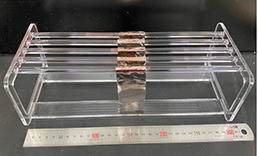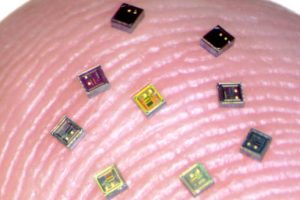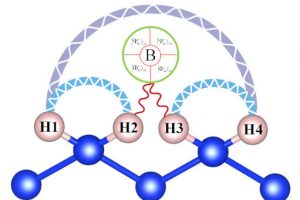24 Japanese companies have set up the Quantum Strategic Industry Alliance for Revolution: Q-STAR. Q-STAR will invite the participation of diverse industries that support its objectives and initiatives, and will collaborate with industry, academia, and government in promoting initiatives that apply new technologies, and establishing related technology platforms. Q-STAR’s concerns include reassessments of basic principles and laws related to quantum ...
Research
The latest electronics research news from within the industry and universities from around the world.
Super stretchy solid-state light
South Korean scientists have made a durable super-stretchable, twistable ac electroluminescent light emitter. The secret is mechanically-reinforced ionogel conductors, according to Pusan National University, where the emitter was developed. “We developed stretchable and durable conductive ionogels with a double-network structure, which is achieved by combining stretchable soft polymer network with stress-resistive hard polymer network,” said researcher Jinhwan Yoon. This ionogel was used ...
Almost perfect graphene grown
Korea’s Institute for Basic Science (IBS) has grown what is thought to be the most perfect artificial graphene yet – with no wrinkles, folds or ‘adlayers’ (islands of multiple-layer graphene) – using a process that appears to be scalable to larger quantities. The same team, from IBS’s Center for Multidimensional Carbon Materials (CMCM), had previously reported single-crystal adlayer-free films of graphene, but ...
Imec and Xanadu engage in SiN
Imec and photonics specialist Xanadu have announced a partnership to develop photonic qubits based on SiN waveguides. Xanadu is developing a quantum computer based on photonics. “Xanadu’s ultimate mission is to build quantum computers that are useful and available to people everywhere,” says Xanadu founder and CEO Christian Weedbrook, “to do this we have the ambitious goal of reaching one million ...
Gold plating makes silver nanowires last a lot longer
Silver nanowires can be drawn down to nanometre dimensions and are finding use in all sorts of chemical and bio-sensing applications, as well as transparent conductive films. They are flexible and the most conductive of the metallic nano-wires, according to the Terasaki Institute in Los Angeles, although they are prone to corrosion. “Silver nanowires have been employed as electrodes in ...
Spin synchroniser could cover a million qubits for quantum computing
Millions of qubits can have their spins synchronised at the same time, according to engineers from the University of New South Wales Sydney, who have developed a way to do it. The challenge is to control the spins of electrons on many quantum dots simultaneously using the magnetic field of a microwave signal. A wire running past qubits is one ...
Seeking insulators that conduct more heat
Better component packaging and power grid performance is the aim of a search for thermally-conductive electrically-insulating materials at the University of Texas at Austin. “The key problem we’ve identified, is that improving thermal conductivity alone is not good enough,” said Austin thermal fluids researcher Vaibhav Bahadur. “You need a more holistic understanding of materials to meet electrical, thermal and mechanical ...
Wireless ‘neurograin’ network connects to brain neurons
Wireless ‘neurograins’, 48 of them, have been used to record rodent neural activity, at Brown University in Rhode Island. The sensing particles independently record electrical pulses made by neurons and send the signals to a central hub outside the skull for coordination and processing. “One of the big challenges in the field of brain-computer interfaces is engineering ways of probing as ...
Entanglement for a million qubit computer?
Japanese scientist have discovered durable entangled protons on a silicon surface, “opening doors to an organic union of classical and quantum computing platforms and potentially strengthening quantum technology”, according to home of the research, Nagoya City University. “Proton entanglement has been previously observed in molecular hydrogen and plays an important role in a variety of scientific disciplines,” said Professor Takahiro ...
Morphing robots inspired by fish fins
Robots could benefit from research into fish fins at the University of Colorado Boulder. Engineer Professor Francois Barthelat has been examining the mechanics that allow fins to be flexible and stiff at the same time, with muscles at the base imparting smooth ripples that exert considerable force on their environment. “You get this dual capability where fins can morph, and ...
 Electronics Weekly Electronics Design & Components Tech News
Electronics Weekly Electronics Design & Components Tech News









